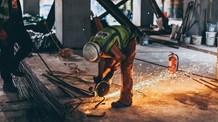Why a culture of rest and recovery should be an industry priority
There’s no doubt that the built environment is forward-thinking, fast-paced and full of opportunity - but like every industry, it has its stressors. Irregular hours. Challenging work environments. Physically taxing labour. Workers in the construction industry can be more vulnerable to burnout than in any other field. Stresses can come from a variety of sources; from those historical concerns more often associated with site work, to newer ones, like materials shortages, exposure to COVID-19 and the rising cost of living, that affect us all. Tackling these stresses and preventing burnout is no easy feat - but how can we as an industry shift the ways in which we think about mental and physical wellbeing and in so doing, develop a culture of rest and recovery?
Working hard isn’t bad for you. It can bring a sense of purpose, of satisfaction and identity. But working long hours and persistent exposure to stress leads to wear and tear on the body and the mind - the so-called allostatic load - and can have a profound impact on our performance at work and our health.
A physically or mentally exhausted employee will make mistakes - and mistakes on a construction site can be fatal. Of course, it is the responsibility of every employer to provide conditions that limit the chance of accident or injury – from risk assessments and adjustments to hydration and rest breaks, to rotating work schedules. But to be truly effective, the industry must consider an integrated, proactive and preventative approach to health, safety and wellbeing and thereby recognise how intrinsically linked each of the three truly are [1].
Before the pandemic, UK workers were already working the longest hours in Western Europe. Advances in technology have, for some time, been blurring the lines between work and home, disrupting our long-established norms of when and where we work and when and where we rest and recover. We are now far less likely to be prioritising rest and recovery - indeed there’s a risk of normalising the idea of never ‘switching off’. There’s a multitude of reasons for this; that blurring of lines between work and home, a sense of duty as the industry and the economy seeks to bounce back as well as to travel restrictions reducing the inclination to take leave.
While all these reasons and feelings are valid in their own way, none of them stand up to the irrefutable truth – without rest and recovery, we can’t live our lives to the best of our ability, let alone be productive in our work.
A whole new skillset
What does good rest and recovery look like? First, we need to understand how crucial time ‘away from task’ is and consider what this looks like in both the micro and the macro. Wherever possible we need: small breaks from a screen throughout the day, a normalised lunch break, as well as using annual leave effectively across the year.
Rest and recovery are skills to be nurtured. Strategies vary, some of them are more active, such as playing sports, while others are passive, like watching television. A model called DRAMMA provides a balanced structure of what good rest and recovery might look like. According to the model proposed by Newman, Tay, and Diener (2014), there are five key elements which promote work recovery and support wellbeing:
Detachment-Recovery: Cognitively disengaging from work-related matters
Autonomy: Doing your own thing
Mastery: Activities with an appropriate balance of challenge and skill
Meaning: Finding purpose in aspects of our leisure time
Affiliation: Connecting with others.
Within the built environment
Rest and recovery requires sustainable effort. A recent study found that working 55 hours or more a week was associated with a 35% higher risk of stroke and a 17% higher risk of dying from heart disease, compared with a working week of 35 to 40 hours. A review of the research literature [2] shows that long hours working, especially when coupled with sleep disruption, causes deterioration of task performance, rates of error [3], pace of work and social behaviour. In a construction environment that can often pose many physical risks, being well-rested can make the world of difference.
To operate effectively at work requires healthy emotional regulation and respectful interactions. Fatigue impairs the ability to judge human facial expressions, social cues and increases our focus on perceived negative events. In an occupational setting, this can result in miscommunication, social misjudgement, and tension between co-workers.
To deliver value in our day-to-day roles requires creativity and good decision making. Physiological and mental recovery are drivers of daily creativity. Down time is essential for boosting motivation, learning from the past, planning for the future, processing new information, making memories, problem solving, maintaining your ability to concentrate, and even sustaining a personal code of ethics. All of these are vital to maintaining the standard required in the built environment.
A positive approach
There is scope for the industry to work on its approach to work allocation, resourcing and stress monitoring - but fundamentally telling people “You’re working too hard” isn’t helpful. We also need to focus on building our understanding of what effective rest and recovery looks like, how to do it better and recognise it as a resource which must be programmed into the way we work.
Building a strong culture of rest and recovery is about ensuring it is hard-wired into the way we as an industry function. The second step is to examine how we might use the time away. If all we are doing is working or thinking about work during these periods, they obviously do not constitute effective rest and recovery at all. All of us, particularly those in decision-maker positions, must not think about this only in terms of other colleagues. It’s crucial to prioritise your own rest and recovery and in doing so demonstrate that you value it. It’s vital that rest and recovery is made a milestone and programmed into delivery plans, project and change programmes and annual leave uptake.
Periods of high demand are inevitable. Often the solution applied is to spend more time doing work at the expense of rest and recovery. Given the evidence tells us this is counter-productive, we should all be seeking to introduce knowledge, skills and resources to develop our working practices, create sustainable productivity and improve health and wellbeing outcomes.
Rest and recovery should be considered at both the individual and organisational level as the ‘protective armour’ when it comes to factors that could have a negative impact on health and wellbeing. Taking a more systematic approach as an employer can help fast track a change in approach. Data is a key aspect of this, ensuring that as an industry we are recording, reporting on and reviewing hours worked, analysing survey trends, absence trends and annual leave uptake. All of this helps to normalise what should become an industry-wide culture of rest and recovery.
References
1) Harvard T.H. Chan School of Public Health - Implementing an Integrated Approach - Weaving Worker Health, Safety, and Well-being into the Fabric of Your Organization - August 2017 - Deborah McLellan, PhD, MHS, William Moore, MS, Eve Nagler, ScD, MPH, CHES, Glorian Sorensen, PhD, MP
2) The Institute for Employment Studies
3) Chronic health problems and risk of accidental injury in the workplace: A systematic literature review - K T PALMER, E C HARRIS, and D COGGON – 16/4/2016












